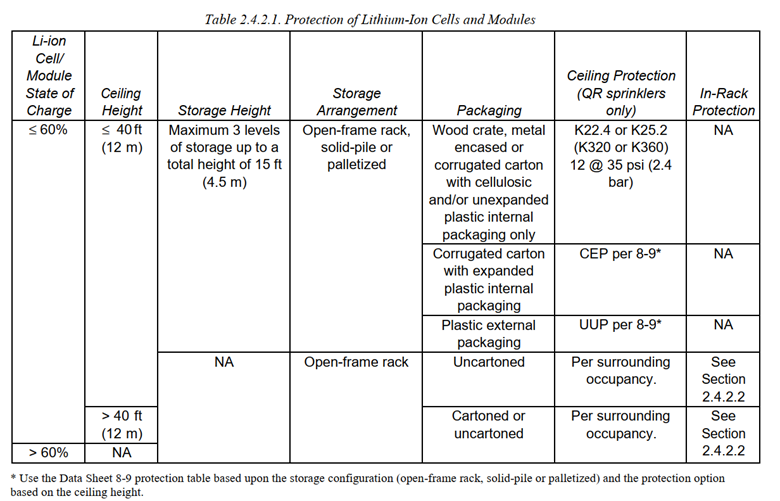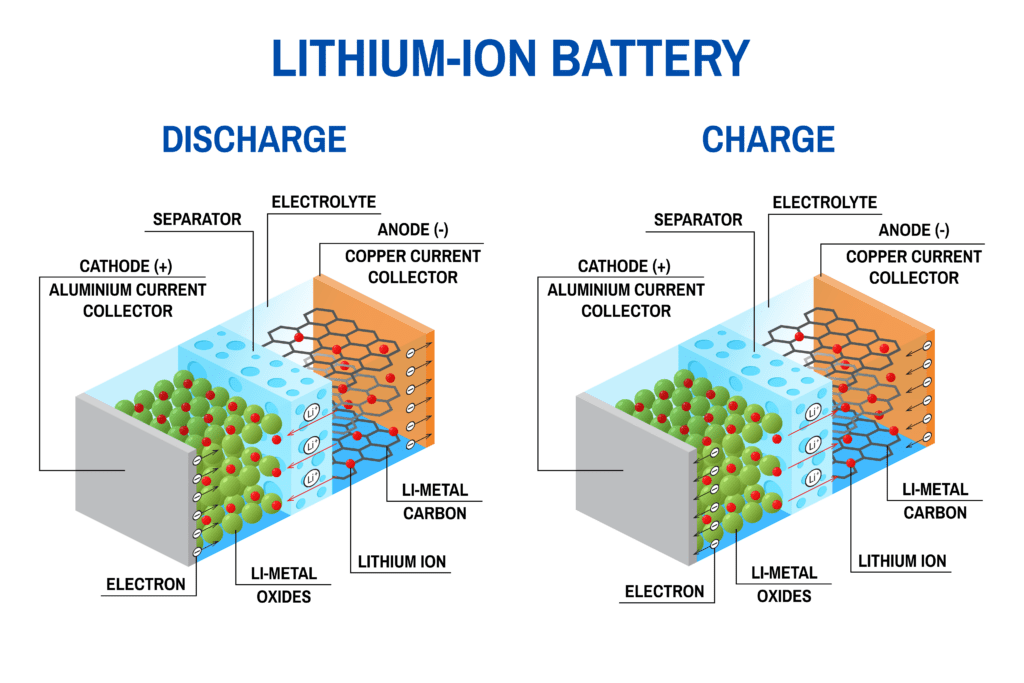Current Protection Standards for Lithium-Ion Batteries: NFSA E&S Insights

NFSA Engineering and Standards (E&S)
April 2024
As lithium-ion (Li-Ion) batteries become ubiquitous in devices ranging from smartphones to electric vehicles (EVs), their high energy density poses new fire safety challenges, including the risk of thermal runaway which can lead to intense fires. To combat these risks, the National Fire Sprinkler Association’s (NFSA) Engineering and Standards (E&S) committee has formed a task group. This group is dedicated to crafting strategies directed at fire protection for lithium-ion batteries. Their efforts are crucial for ensuring that advancements in battery technology proceed with the necessary safety measures to protect lives and property. The NFSA’s Engineering and Standards (E&S) committee task group was tasked with producing the latest fire protection for lithium-ion batteries, electric vehicles, and other applications. The NFSA E&S Li-Ion Task Group consists of:
- Ernie Rodriquez, Chair – Wiginton Fire Systems
- Cecil Bilbo – Sprinkler Academy
- Chase Browning – Medford, OR Fire Department
- Jeff Dunkel – Fire Protection Engineer, NFSA staff
- Jeff Hewitt – CHA Fire Protection Services, LLC
- Greg Maurer – Wheatland Tube
- Michael Newell – Belvedere, LLC
- Greg Ohnemus – ASC Engineered Solutions
- William Roberts – Quick Response Fire Protection, Inc.
- Manny Silva – Johnson Controls, Inc.
- Jonalyn Telesz – Wheatland Tube
- Brandon Telford – Reliable Sprinkler
- Karl Wiegand – Victaulic
Summary of Lithium-ion Battery Hazards
The following is a summary of the lithium-ion battery hazards and the prescriptive sprinkler criteria currently available for each. Since NFPA 13 does not cover fire protection for lithium-ion batteries, the available criteria for fire protection design are limited.
At its meeting in December of 2023, the task group discussed the following considerations for fire protection:
- Bulk Battery Storage
- Energy Storage Systems
- Waste Management Facilities
- Electric Vehicles
- Micro Mobility Devices
Fire Protection for Bulk Battery Storage
The hazard for bulk storage or warehouse storage is reduced significantly when compared to ESS since most of the mechanisms that cause thermal runaway are not present. However, the hazard remains considerable. If the storage did ignite the fire is difficult if not impossible to control. The only prescriptive criteria are provided by FM Global Data Sheet 8-1

FM DS 8-1, Table 2.4.2.1 limits State of Charge in these storage scenarios.
Note on state of charge: Fire Safety Research Institute (FSRI) performed a side-by-side test of identical lithium-ion battery modules at different states of charge (SOC). One module was at 100% SOC and the other module was at 30% SOC. The module at 100% SOC demonstrated a more volatile and faster thermal runaway, as well as a faster propagation of thermal runaway between cells within the pack, than the 30% SOC module.
Reference Citation: The Science of Fire and Explosion Hazards from Lithium-Ion Batteries Training Course
DOT regulations limit SOC to 30% for certain forms of lithium-ion battery transport by air.
Reference Citation: Transporting Lithium Batteries | PHMSA (dot.gov)
At the task group’s meeting in December, Phil Friday, Reliable Fire Sprinkler Director of Engineering Applications, gave a summary of their Model LB11 sprinkler development – HSW In-Rack Sprinkler design developed for protection of lithium-ion batteries in manufacturing facilities, specifically in formation, aging, and shipping/staging racks.
There is currently no standard test commodity for lithium-ion batteries. Thus, standard exposed expanded Group A plastic commodity was used in listing tests. Further testing of the Model LB11 HSW sprinkler, beyond the listing, was conducted with lithium-ion batteries as described in this Reliable Bulletin 084 (Link below):
Reference Citation: 084.pdf (reliablesprinkler.com)
Fire Protection for Energy Storage Systems

Diagram of a lithium-ion battery
Energy Storage Systems range greatly, they can be used for battery backup for a single-family home or provide peak shaving for the entire electrical grid. Chapter 12 was added to the 2021 edition of the International Fire Code (IFC) which only applies when the ESS exceeds 20 kWh. The Maximum Allowable Quantities (MAQ) of a lithium-ion ESS is 600 kWh. NFPA 855 also provides prescriptive requirements which are as follows:
- 0.3 gpm/ft2 over 2,500 sq.ft – Only applies with the following arrangement
- Maximum 600 kWh in a single fire area (does not apply to dedicated use buildings)
- ESS must be separated in groups of 50 kWh 3 feet apart
- When the size and separation criteria cannot be met testing must be provided via 9540A. It is not economical for large scale ESS to meet the size and separation requirements therefore the vast majority of facilities are developed through UL 9540A.
Reference Citation: NFPA 855
Fire Protection for Waste Management Facilities
The EPA released a report in 2021 describing a significant increase in waste management facility fires caused by improperly discarded lithium-ion batteries. The IBC/IFC and NFPA 13 already cover waste management facilities. It appears there are a significant number not protected or protection should be increased. NFPA 850 provides fire sprinkler protection requirements for Tipping floors and storage pits at MSW Mass burn plants and RDF plants. Current tipping floor FS design requires a minimum density of 0.25 gpm/SF over 3,000SF. There are also companies marketing remotely controlled and automated monitor nozzles as a direct replacement for fire sprinklers for waste management facilities.
Reference Citation: NFPA 850, Alternative Fuels Section
Fire Protection for Electric Vehicles (EVs)
The primary concern with EVs in regard to sprinklers is of course parking garages. Statistically EVs are less likely to catch fire than an internal combustion engine, however when they do it’s difficult to put out. NFPA 13 has increased the recommended hazard classification from OH1 to OH2, depending on future data EH1 may be more appropriate. Though less likely to ignite, EVs have the potential to enter thermal runaway with little outside influence, or they can be damaged and thermal runaway may happen hours after. This increases the potential for a fire in residential garages, which are mostly non-sprinklered. Chevrolet issued a recall asking owners to park their Bolt EUV outside the garage and away from structures and suggested not to charge overnight. Overcharging can cause thermal runaway. This and potentially delayed event from previous damage could increase the need for sprinklers in single family homes as EVs are more common.
NFPA 88A Tech Committee had a pre-first draft meeting in St. Petersburg, FL, in October 2023. The major topic of discussion was EV hazard, especially charging area protection and ancillary storage areas for micro-mobility devices. There was a desire of the committee for more involvement/input from EV manufacturers. NFPA 88A first draft meeting will most likely be in the fall (Sept/Oct) of 2024.
Municipalities are amending local ordinances to increase fire sprinkler protection for parking garages with charging stations for new parking garages being built within their jurisdictions. This is happening in Miami Dade County, where areas over charging stations are to be protected with minimum Extra Hazard Group II and 2.5” hose within the vicinity.
Fire Protection for Micro Mobility Devices
One cause of thermal runaway is manufacturer’s defect; this was the case with the Samsung Galaxy Note 7 phones incidences in 2016. Cheaper battery cells increase the risk of thermal runaway. Inexpensive, micro mobility devices are much more prevalent in cities. Places like New York City are seeing large numbers of fires caused by these devices. Along with cheaper consumer models there are also commercial or rentable devices that are publicly available. Some companies crowdsource the charging of the batteries, paying people that charge the devices for them. This is a problem because batteries are often charged incorrectly in large numbers close together, often in corridors or other egress paths.
The use of micro-mobility devices often involves handling that can lead to wear and tear, such as the jarring effects from running over obstacles like curbs and potholes. Furthermore, the use of mismatched chargers and modifications to achieve a greater range per charge can also impact their functionality and safety.
Reference Citation: Samsung finally explains what went wrong with those Note 7 batteries. (2017, January 23). NBC News.
In September 2022, NFPA, FSRI and FDNY collaborated on fire testing of micro mobility e-scooters in a residential occupancy. These tests revealed that:
- “Following ignition of a Li-ion battery fire, the time to flashover was less than 1 minute as opposed to the 3 to 5 minutes need from flaming ignition on upholstered furniture in a room.”
- Residential automatic fire sprinklers are effective in preventing flashover. “In the fire experiments conducted, the residential automatic fire sprinklers activated and prevented flashover.”
Reference Citation: D. Madrzykowki, C. Weinschenk, “Fire Safety of Batteries and Micro-Mobility Devices,” SFPE Fire Protection Engineering, Q4 2023, Issue #100
Appendix A: To attempt to put things into perspective, this graph projects growth of Li-ion battery demand to grow 27% per year to 2030.

This growth represents a 7-fold increase between 2022 and 2030.
4.7GWh is equivalent to:
- 1,460,000 Utility-scale Wind Turbine generators.
- 450 billion 18650 Li-ion cells.
The NFSA and Its Members Remain Committed to Combatting Lithium-Ion Battery Fires
The NFSA and its membership will continue to work at all levels to protect lives and property. As the world changes, so do the ways in which we protect it, which is why NFSA members and staff work together to meet new challenges. Lithium-ion battery fires are just one example of a growing list of fire threats.
Luckily, NFSA’s influence has helped to shape codes and standards that keep America safe. For more information on NFSA’s mission, or to join our association and work with us to protect lives and property, visit our membership page.
